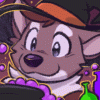
I wanted to draw north being a fluffy baby... I slowly drew 'em getting older and older.
The first two stages have egg horns on their noses. It helps the baby arctic rapter get out of their egg! As they grow, arctic rapters egg horn either falls off, or becomes a fully formed face horn. With North's case, it fell off.
Babies are born with super fluffy feather coats. It keeps them warm and dry. It's so thick you don't see the tiny horns growing underneath.
If you feel around their feathery head you can maybe feel the little horn nubs.
Only the biggest horns (North's two white protruding ones) can be seen. Small velvet like feathers cover the horns. As they grow into full maturity, the short feathers will molt off, revealing the true horn color underneath. A true color could look the same as the velvet feathers. Young rapters will be excited to see this change.
As the baby grows, they become more active. Running around investigating, scratching and biting things. Feathers most often fall off the feet first.
Snow will clump and weigh down the rapters otherwise. This also reveals the rapters true scale color underneath all the feathers.
Growing brings more molting. The rapters don't need such a big fluffy coat anymore. It weighs them down, it can actually overheat them. Depending on where they live. As such, the fluffy outter feathers shed. More undercoats and scales can be seen. An overcoat is most often not the same color as undercoats. Example : a fluffy coal colored arctic rapter shedding to reveal white and green undercoat.
North's belly and arms have short blue feathers he kept from childhood. Some rapters lose this right away. Some mold partially, or keep it for the rest of their lives.
Nearing full maturity; The blue undercoat shed to reveal golden scales.
Horns shed their velvety layer to become stark ebony horns.
Adult mate feathers start to protrude. A sign of maturity, and your true self. No longer seen as a teen, but a seasoned rapter. Newly adult rapters are proud and show off, make dances and strut around like they own the place. Or thats what they used to do when they were more primitive. Though in small clans they still dance in a rite of adulthood. Your personality shining more than your new fancy feathers.
Males have more mature feathers then females, though sometimes one or the other can still be confused with the other sex in small cases.
The first two stages have egg horns on their noses. It helps the baby arctic rapter get out of their egg! As they grow, arctic rapters egg horn either falls off, or becomes a fully formed face horn. With North's case, it fell off.
Babies are born with super fluffy feather coats. It keeps them warm and dry. It's so thick you don't see the tiny horns growing underneath.
If you feel around their feathery head you can maybe feel the little horn nubs.
Only the biggest horns (North's two white protruding ones) can be seen. Small velvet like feathers cover the horns. As they grow into full maturity, the short feathers will molt off, revealing the true horn color underneath. A true color could look the same as the velvet feathers. Young rapters will be excited to see this change.
As the baby grows, they become more active. Running around investigating, scratching and biting things. Feathers most often fall off the feet first.
Snow will clump and weigh down the rapters otherwise. This also reveals the rapters true scale color underneath all the feathers.
Growing brings more molting. The rapters don't need such a big fluffy coat anymore. It weighs them down, it can actually overheat them. Depending on where they live. As such, the fluffy outter feathers shed. More undercoats and scales can be seen. An overcoat is most often not the same color as undercoats. Example : a fluffy coal colored arctic rapter shedding to reveal white and green undercoat.
North's belly and arms have short blue feathers he kept from childhood. Some rapters lose this right away. Some mold partially, or keep it for the rest of their lives.
Nearing full maturity; The blue undercoat shed to reveal golden scales.
Horns shed their velvety layer to become stark ebony horns.
Adult mate feathers start to protrude. A sign of maturity, and your true self. No longer seen as a teen, but a seasoned rapter. Newly adult rapters are proud and show off, make dances and strut around like they own the place. Or thats what they used to do when they were more primitive. Though in small clans they still dance in a rite of adulthood. Your personality shining more than your new fancy feathers.
Males have more mature feathers then females, though sometimes one or the other can still be confused with the other sex in small cases.
Category Artwork (Digital) / All
Species Unspecified / Any
Size 1280 x 370px
File Size 95 kB

 FA+
FA+









Comments